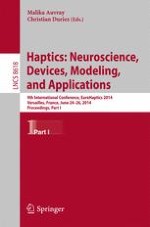2014 | OriginalPaper | Buchkapitel
Does Just Noticeable Difference Depend on the Rate of Change of Kinesthetic Force Stimulus?
verfasst von : Amit Bhardwaj, Subhasis Chaudhuri
Erschienen in: Haptics: Neuroscience, Devices, Modeling, and Applications
Verlag: Springer Berlin Heidelberg
Aktivieren Sie unsere intelligente Suche, um passende Fachinhalte oder Patente zu finden.
Wählen Sie Textabschnitte aus um mit Künstlicher Intelligenz passenden Patente zu finden. powered by
Markieren Sie Textabschnitte, um KI-gestützt weitere passende Inhalte zu finden. powered by
